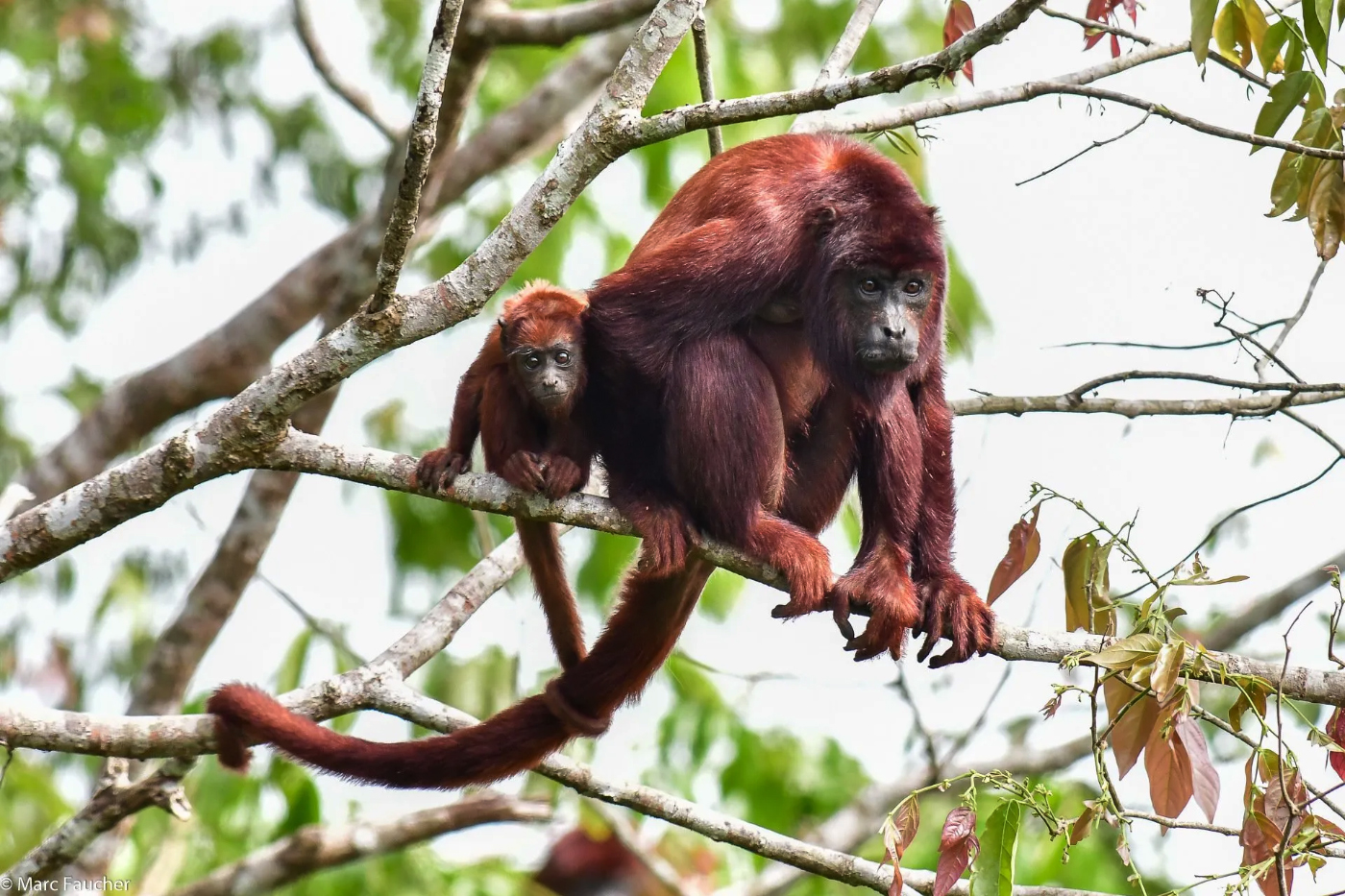Howler Monkeys and Beyond: A Journey Through Primate Diversity in Manu Reserve
Howler monkeys are truly fascinating primates, best known for their incredibly powerful vocalizations that echo through the jungle. They are common inhabitants of tropical forests from Mexico down to Argentina, including Peru’s Manu Reserve.
Key Characteristics
- Size: They are among the largest New World monkeys. Males are generally bigger than females, reaching up to 28 inches (72 cm) in body length, plus a long prehensile tail that can stretch up to 30 inches (75 cm).
- Fur: Their dense fur varies in color, from deep black to rich reddish-brown tones, depending on the species. Their faces are typically bare and dark, often framed by a facial beard.
- Prehensile Tail: Howlers possess a long, strong tail that acts as a “fifth limb” for gripping branches and moving with agility through the forest canopy, where they spend most of their lives. They rarely descend to the ground.
- Sound-Adapted Anatomy: They have an enlarged hyoid bone in their throat, which acts like a resonating chamber. This unique adaptation allows them to produce their distinct, booming howls, which can be heard for several miles.
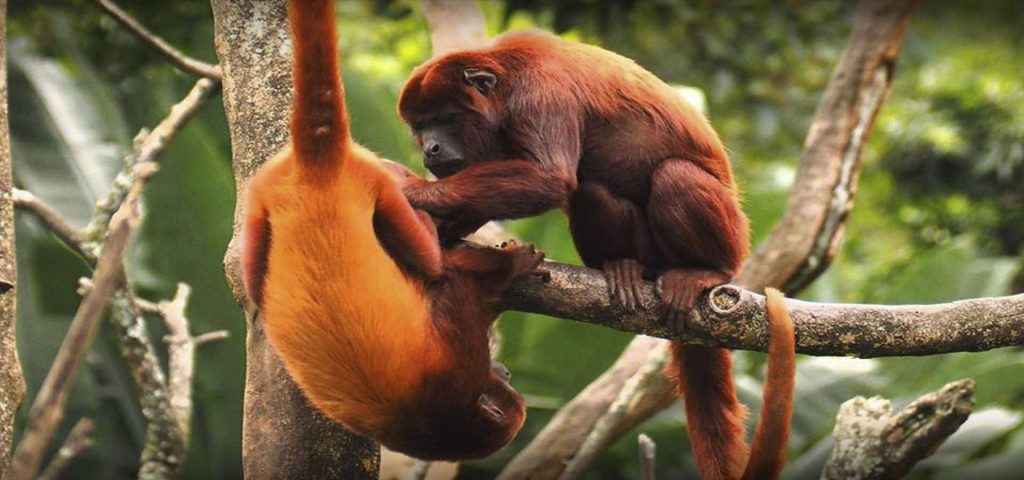
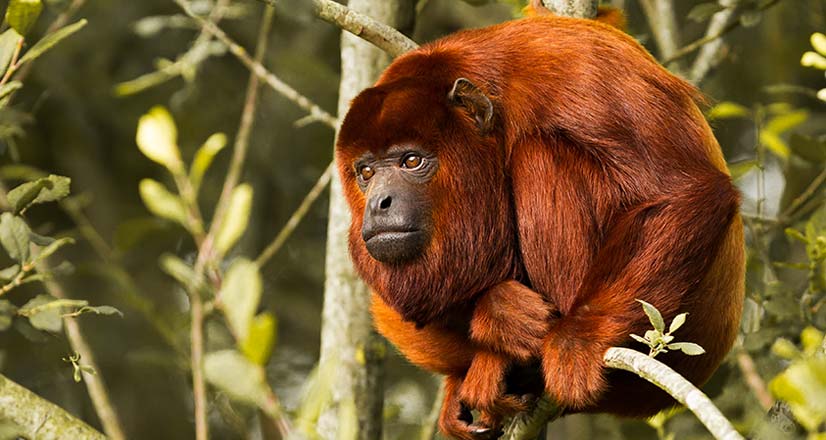
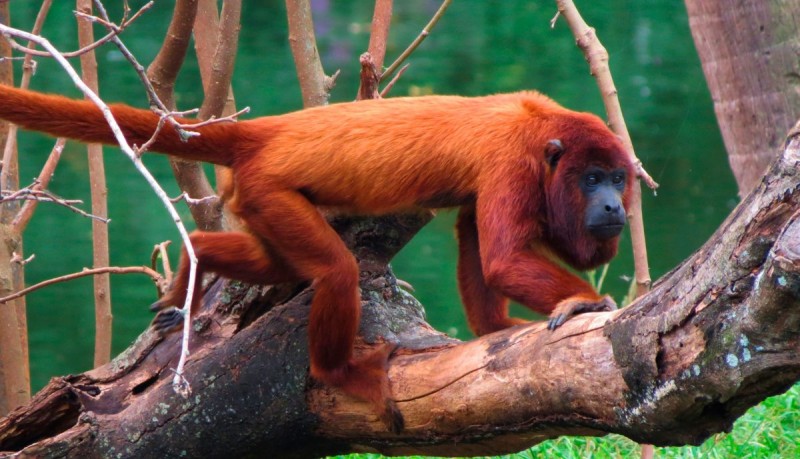
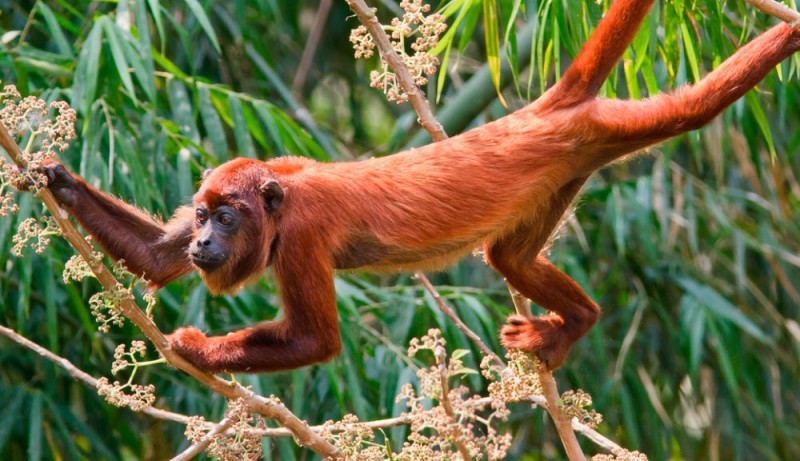
Behavior and Diet
- Vocalizations: Their famous howls aren’t aggressive, but rather a form of territorial communication. They use them to delineate their space and announce their presence to other groups. They also help coordinate activities within their own troop.
- Arboreal Life: Howler monkeys are primarily arboreal, living high in the treetops where they find food and shelter from predators.
- Diet: They are mainly folivores-frugivores, meaning their diet primarily consists of tender leaves, shoots, and, when available, fruits and flowers. Since the cellulose in leaves is difficult to digest, howlers spend a significant portion of their day resting to process their food.
- Social Groups: They live in social groups that vary in size, composed of adult males and females, as well as younger individuals.
Howler monkeys are an unforgettable sight—and especially sound—on any expedition through the Amazon, and the Manu Reserve is a prime location to observe them.
You can spot howler monkeys in the Manu Reserve year-round, as they are permanent residents of the Amazon rainforest. However, your chances of a clear sighting and an overall better experience can vary with the seasons:
Dry Season (May to October)
- Better Visibility: During these months, there’s less rain, which means trails are drier and easier to navigate. Rivers and cochas (oxbow lakes) have lower water levels, which tends to concentrate wildlife, including monkeys, near remaining water sources. This often makes them easier to spot.
- More Comfortable Weather: Generally, days are sunny and temperatures are pleasant, although it can still be hot and humid. Nights are a bit cooler.
Wet Season (November to April)
- Vibrant Jungle: The rainforest is at its most lush and green due to the rains. This can be spectacular for nature lovers and photographers.
- Increased Activity: Some reports suggest that during the wet season, animal activity increases due to the abundance of food (flowers and fruits).
- Potential Challenges: Rains can be intense and frequent, potentially making some trails muddy or slippery, and river levels can rise, affecting navigation. However, this can also open up new water routes for exploration.
In summary:
If you prioritize comfortable trails and a higher likelihood of concentrated wildlife sightings, the dry season (May to October) is generally considered the best.
If you’re drawn to the idea of a rainforest at its most vibrant green and don’t mind occasional downpours, the wet season (November to April) still offers a very rewarding wildlife experience, with the possibility of seeing more active animals.
Either way, the distinctive howls of the monkeys are a constant soundtrack in Manu, so their presence is almost guaranteed!
Beyond the Howls: What Every Traveler Should Know About Howler Monkeys in Manu
Besides their unmistakable calls, there’s so much more to learn about these fascinating creatures inhabiting the Manu Reserve:
- The Species You’ll Encounter in Manu:
- Primarily, in Manu, it’s common to spot the Red Howler Monkey (Alouatta seniculus). Their distinctive reddish fur makes them quite visible in the canopy. Knowing the specific species they might see adds an interesting detail to their experience.
- Why Do They Howl? More Than Just Territorial:
- While they do mark territory, their howls are also a tool for long-distance communication. They serve to warn other groups about the presence of predators (like jaguars or Harpy Eagles), to coordinate their own group’s movements at dawn and dusk, and even to signal the location of food sources.
- Howls are often more frequent at dawn and dusk, offering a sound spectacle travelers will never forget.
- Their Vital Role in the Manu Ecosystem:
- Howler monkeys are important seed dispersers. Although most of their diet consists of leaves, they also consume fruits, and as they move through the forest, they spread seeds through their droppings, aiding in the regeneration of the jungle.
- Their presence and behavior are indicators of the health of the ecosystem; a healthy ecosystem allows for a robust howler monkey population.
- Where and When to Best See Them in Manu:
- Although present throughout the reserve, they are often easier to observe in primary and mature secondary forest areas, especially near rivers and cochas (oxbow lakes). Their arboreal habits mean that observation from boats in the cochas or slow walks along elevated trails offer the best opportunities.
- As they are predominantly diurnal, mornings and late afternoons are the most active times for observation.
- Tips for Respectful Observation:
- Maintain distance: It’s crucial not to disturb their natural behavior. Professional guides know the safe viewing distance.
- Silence and patience: Successful sightings often require quietness. Sudden movements and loud noises can scare them away.
- Do not feed them: Feeding wildlife is harmful to their health and alters their natural behavior.
- Photography: Using zoom lenses is ideal for getting good photos without getting too close.
- Conservation: Why Are They Important?
- Although the Red Howler Monkey is relatively common, they are under threat from deforestation, habitat fragmentation, and, in some areas outside the reserve, hunting.
- By visiting the Manu Reserve, travelers directly contribute to the conservation of these species and their habitat, as part of the proceeds are allocated to protection projects.
This information not only educates the traveler but also fosters a deeper appreciation for the unique wildlife and ecosystem of Manu.
